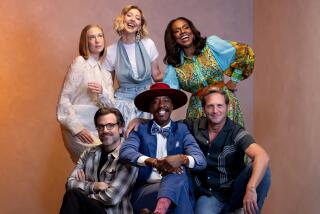Has he got a story for you
- Share via
Vaudeville killed Armond Fields’ grandfather. Of that, the poor man’s wife was certain.
If Max Fields had remained a tailor, he might have lived. But his younger brother, Lew, one of America’s most famous stage comedians before the talkies came in, persuaded Max to give up the shmattas and go on the road. He became the advance man for Weber & Fields, the knockabout-comedy duo that rose to the top in vaudeville while creating or perpetuating shtick that would later serve the Three Stooges and Abbott and Costello.
The traveling grind -- another week, another city -- was tough. Max caught tuberculosis in 1900 and died two years later. His outraged widow, Leah, blamed Lew Fields and cut off contact with his side of the clan. And so Armond, born in 1930, grew up deprived of the showbiz immersion that should have been his birthright.
Now Fields’ recapturing of a nearly lost past -- his own and much more -- is on display at USC. “Setting the Stage: The Rise of American Popular Theater” runs through Dec. 9 in Doheny Memorial Library’s Treasure Room exhibition gallery. The investigation of his family’s history that began in almost complete ignorance 20 years ago quickly sparked in Fields a fascination for everything that happened on American stages before talking cinema. He has written eight books on old-time actors and singers, starting with an account of Lew Fields’ 60-year career as a performer and impresario, reflecting the birth and death of vaudeville and the advent of the modern Broadway musical.
The 103 artifacts in the exhibition at USC, dating from 1794 to 1930, are culled from more than 2,000 pieces Fields donated to the university two years ago. The show, which he curated, includes posters, theater programs, sheet-music covers, souvenirs and some rare film footage of vaudevillians, including Weber & Fields.
Armond Fields grew up in Milwaukee knowing nothing about the New York-based great-uncle who made America laugh, then emerged as a leading Broadway producer whose shows included four early musicals by Rodgers and Hart. Armond had no contact with Lew’s kids -- his cousins Dorothy, Herbert and Joseph Fields -- as they collectively amassed lyricist or librettist credits on dozens of Broadway and Hollywood musicals, including “Sweet Charity,” “Annie Get Your Gun” and “Flower Drum Song.”
Armond’s father, Lewis Fields, was a traveling salesman dealing in draperies and dry goods. Armond earned a liberal arts doctorate from the University of Chicago, then went into advertising, where his specialty was researching the public’s moods and tastes. Art was his passion: He collected prints from the late 1800s and early 1900s, a period he was drawn to because of its social and creative ferment. He wrote books about two French graphic artists of the period and had some success selling silkscreens and oil paintings he created in the studio at the back of his modest stucco cottage in Culver City.
In middle age, he decided to seek his roots and was astonished to discover he was related to showbiz royalty. His initial research yielded “From the Bowery to Broadway: Lew Fields and the Roots of American Popular Theatre,” a 552-page study written with his son, L. Marc Fields, and published in 1993 by Oxford University Press.
Fields has since written seven more biographical works about vaudevillians. Some of his heroes already have fallen from memory; the names of others may ring a bell, but they’re rapidly being crowded out of the collective mind. Oh, what a world in which Paris Hilton is omnipresent while oblivion threatens such Fields biography subjects as Lillian Russell, Sophie Tucker, Maude Adams and Eddie Foy, stars who shined through decades but who lived or peaked too soon for screen stardom.
The exhibition aims to sketch in the vast blank that precedes film for most entertainment consumers and even for many showbiz-history mavens. Glancing to the right upon entering the elegantly dark-wood-paneled and colorfully frescoed gallery, one encounters a visual joke: an iPod mounted as an artifact inside a museum case. But it has a serious sonic purpose, playing a loop of songs by Al Jolson and others that keeps a merry, old-time tootle in the air.
Among the 18 chronologically arranged display cases is one dealing with minstrelsy -- which Fields counts as America’s first indigenous form of performance. Whites blackened their faces and sang, danced and did skits and monologues in an exaggerated slave dialect, picking up on and perpetuating racist stereotypes. Vicious as those were, Fields thinks the impulse behind the genre was to entertain the white masses rather than to mock the black minority. Touring minstrel shows were popular for more than 40 years, into the 1880s. Fields says the minstrels established political satire as an enduring staple of American comedy. “They would read a newspaper story, get onstage, and make fun” of the happenings of the day.
Context is important, Fields believes, and the exhibition notes the social and economic pressures that shaped entertainment. After the Civil War, as immigration picked up, melodrama became popular, with heroes pure as snow and mustache-twirling villains acting out plotlines in which the nation’s bedrock values were threatened, then affirmed. “They were pushing the Protestant ethic; they wanted to preserve their culture. But when it got to the point where the culture became so diversified [through immigration], they couldn’t do that anymore” and still succeed in the marketplace.
Enter variety shows and vaudeville (a term that, as a wall text informs us, “likely derives from an old French term for pastoral plays”), in which the multiple-act bills sought to offer something for everyone -- animal acts and acrobats, hoofers and comics, ballerinas and balladeers. Weber & Fields would retool their routines to give them broader ethnic appeal: “One week you’d do it in blackface, then in Irish dialect, then Dutch dialect,” Fields says, “Dutch” being the trade’s term for a German-Yiddish amalgam.
“Eventually, everyone was targeted. The popular theater was the only place [recent immigrants] could go and be relaxed and laugh at themselves.”
For Fields, there is a tinge of melancholy in this gallery given to performers whose main aim was to give folks a lift. The vaudeville figures who made it into hit films -- Jolson, Eddie Cantor, W.C. Fields, Mae West -- inherited posterity. Others, no matter their talents and popularity, are known only to scholars and theater-history buffs.
“Lillian Russell was the Madonna of her day, the Mae West, the Marilyn Monroe. She was married four times, she was her own manager, and she was outrageous in everything she did. Who knows Lillian Russell today, except a few people interested in early theater? Who knows Eddie Foy? They have vanished, and celebrity is fleeting.”
But at age 75, Fields is hardly through with them. He recently sent the manuscript for his next book, “Women Vaudeville Stars: Eighty Biographical Profiles,” to McFarland & Co., his North Carolina-based publisher. Next project: a biography of Tony Pastor, the impresario who launched vaudeville. “I’m doing it because these people were so important in their era and because of the contributions they made.”
*
‘Setting the Stage: The Rise of American Popular Theater’
Where: Doheny Memorial Library, USC campus
When: 8 a.m. to midnight,
Mondays through Thursdays;
8 a.m. to 5 p.m., Fridays;
9 a.m. to 5 p.m., Saturdays;
1 to 10 p.m., Sundays.
Ends: Dec. 9
Price: Free
Contact: (213) 740-2070
More to Read
The biggest entertainment stories
Get our big stories about Hollywood, film, television, music, arts, culture and more right in your inbox as soon as they publish.
You may occasionally receive promotional content from the Los Angeles Times.











